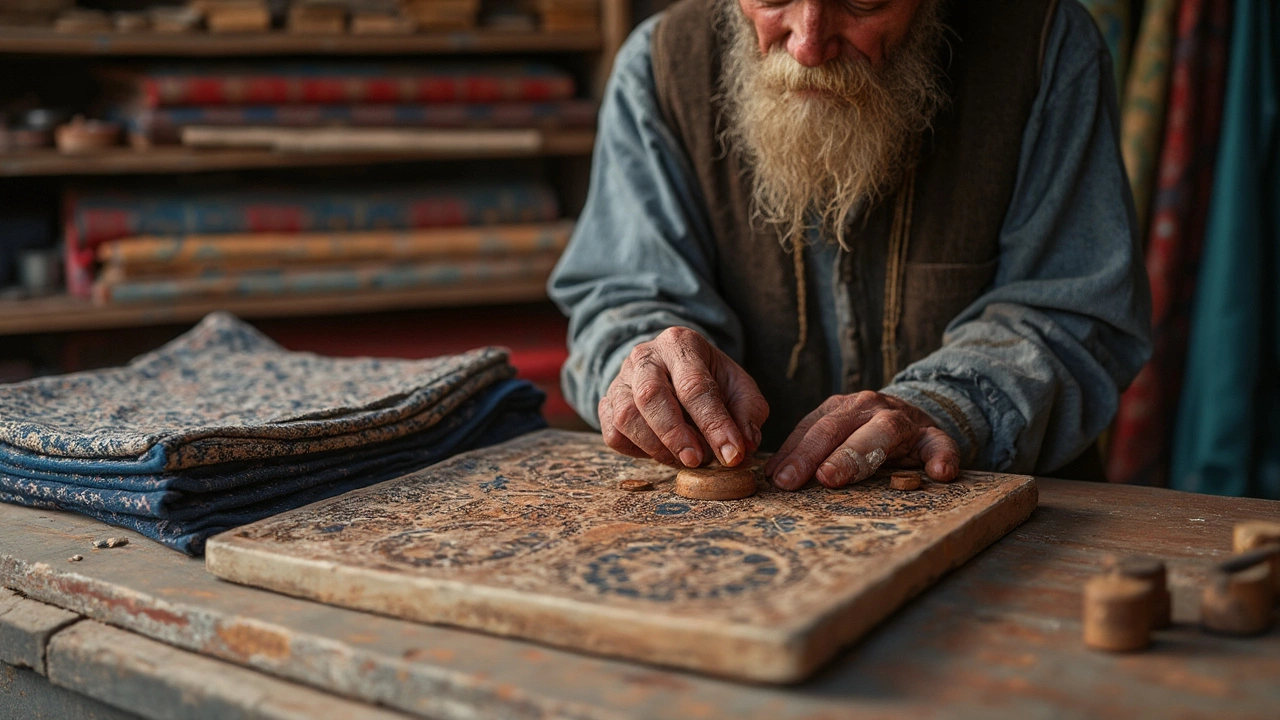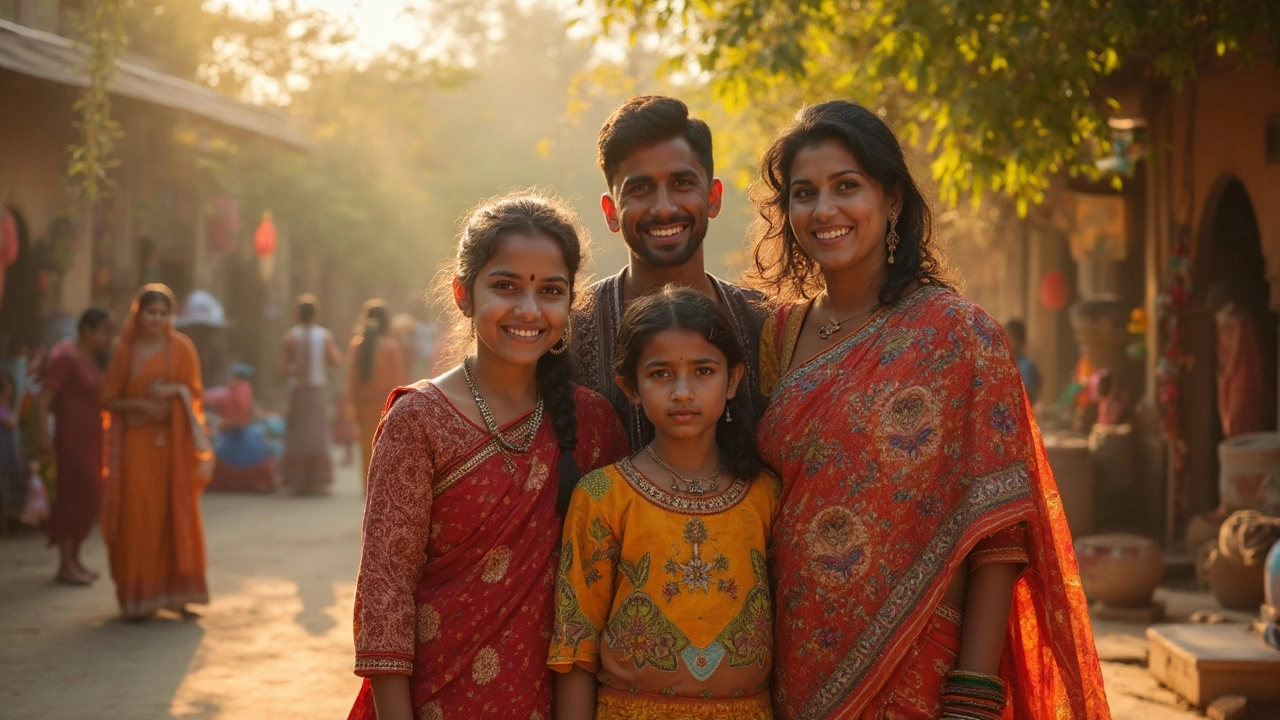Ever wondered why Gujarat keeps popping up whenever people talk about Indian textiles? There’s a good reason—this state isn’t just making cloth, it’s shaping trends that reach closets around the world. You’ll hear names like Bandhani and Patola thrown around a lot, but what actually sets Gujarat’s fabrics apart from the rest?
Gujarat’s textile story is not just about pretty patterns or bright colors (though, trust me, there are plenty!). It’s about techniques passed down from generation to generation, whole towns working together, and families who’ve made fabric their life’s thing. Walk into a typical Gujarat market and you’ll spot women in vibrant Bandhani sarees or see jaw-dropping Patola fabrics selling for the price of a scooter. That’s how much people value the skill behind these fabrics.
Want to buy something truly local and not mass-produced? Knowing what makes Gujarat’s cloth famous will help you spot the good stuff. There’s a lot more to these textiles than eye-catching designs—they come with stories, hard work, and secrets only the true experts know.
- Gujarat’s Textile Roots
- The Big Names: Bandhani, Patola, and More
- The Artisans and Their Craft
- Tips for Buying Authentic Gujarat Fabric
- Why Gujarat Leads India’s Textile Game
Gujarat’s Textile Roots
It’s wild to think about this, but Gujarat’s textile game has been strong for basically 5000 years. The state was a key player all the way back during the Indus Valley Civilization. Archaeologists have dug up old cotton fabrics in places like Lothal and Dholavira—clear proof that cotton weaving was a big deal before phones, cars, or even coins.
Fast forward to medieval times, and Gujarat was a main hub for trading cloth to the Middle East and Europe. The ports of Surat and Cambay (now Khambhat) put Gujarat’s fabrics on the map internationally. If you know your history, you’ll remember that European traders, including the British, landed here not for spices at first—but for the famous Gujarat cloth.
Gujarat isn’t just stuck in the past. By 2023, the state had well over 150,000 small and medium textile units. The cities of Ahmedabad and Surat make up India’s biggest textile centers. Ahmedabad was once called the “Manchester of the East” because of its mammoth textile mills during the 20th century. Even today, Surat handles around 40% of India’s total man-made fiber production.
| City | Claim to Fame | Specialty Product |
|---|---|---|
| Ahmedabad | Historic textile mills | Cotton & khadi fabric |
| Surat | Largest textile processing center | Synthetic fabrics |
| Jetpur, Bharuch | Ancestral weaving towns | Bandhani, Patola |
If you ask anyone from Gujarat, they’ll say textile isn’t just about making cloth. Generations of families—sometimes whole villages—depend on it. The art and business are tightly woven into everything, from festivals to family gatherings.
The Big Names: Bandhani, Patola, and More
If you mention Gujarat and cloth in the same breath, two names always come up: Bandhani and Patola. These aren't just any fabrics—they're at the heart of Gujarat’s textile identity and have been stealing the spotlight for centuries.
Bandhani is what most people think of when they picture Gujarat’s traditional wear. This is a tie-dye art where small portions of fabric are tied tightly with thread and then dyed, creating hundreds of tiny dots and bold patterns. Vibrant reds, yellows, and greens are classic Bandhani colors. The best part? Every Bandhani piece is different because it’s made by hand. The city of Jamnagar is especially famous for high-quality Bandhani sarees, and you’ll see these worn all across weddings and festivals in Gujarat.
Then there’s Patola, the real showstopper. Patola sarees are double ikat, which means both the warp and weft threads are dyed before weaving. That alone makes the process intense—one saree can take four to six months to make. Patan is where most of these rare pieces come from, and prices can easily run well above ₹1 lakh for a genuine Patola. The designs often feature bright colors and geometric patterns, making each saree a piece of art.
But Gujarat doesn’t stop there. You’ve also got:
- Ajrakh: Traditional block printing using natural dyes and precise geometric patterns, mostly produced in Kutch. The colors come from natural things like indigo (blue) and madder (red).
- Khadi: Simple, hand-spun and handwoven cotton fabric. It’s lightweight, eco-friendly, and once championed by Mahatma Gandhi himself in Gujarat.
- Kutch Embroidery: This goes beyond fabric—it’s all about bright threads, mirrors, and beads, mostly used on shawls, bags, and blouses.
Here’s a quick look comparing the famous Gujarat fabrics:
| Name | Main Area | Key Feature | Approx. Time to Produce |
|---|---|---|---|
| Bandhani | Jamnagar, Rajkot | Tie-&-dye, dotted patterns | 2-3 days for saree |
| Patola | Patan | Double ikat weaving | 4-6 months for saree |
| Ajrakh | Kutch | Block printing, natural dyes | 1-2 weeks for dupatta |
| Khadi | Statewide | Hand-spun, eco-friendly cotton | Varies (depends on length) |
| Kutch Embroidery | Kutch | Mirrorwork, colorful threads | 1-4 weeks for piece |
These fabrics aren’t just about style—they help thousands of families earn a living. When you buy any of them from Gujarat, you’re picking something unique, handmade, and packed with skill.

The Artisans and Their Craft
Gujarat’s textile scene is powered by thousands of artisans who bring age-old designs to life. These folks don’t just know how to tie a knot or weave a thread; they master techniques that have been kept alive for hundreds of years — all without much modern machinery.
Take Bandhani, for example. This tie-dye style is still done by hand in places like Jamnagar and Kutch. The process? Simple in theory, but easy to mess up: tiny threads are tied around small sections of fabric to create patterns, then dunked into dye. A single saree can need up to 20,000 hand-tied knots. No two Bandhani pieces ever look exactly the same.
"The skill of Gujarat’s weavers isn’t just about talent, it’s about discipline — sometimes it can take a team months to create just one piece," says textile historian Rahul Jain.
Let’s not skip Patola. This double ikat fabric from Patan uses a seriously complex method where both threads—warp and weft—are dyed with the patterns before weaving. You read that right: the pattern is made even before the actual weaving begins. Some Patola sarees take up to a year to finish. The Salvi family in Patan has done this since the 1100s!
Check out the numbers behind Gujarat’s textile artisans:
| Textile Art | Main Artisan Area | Avg. Time to Complete (1 Saree) | Artisans Involved |
|---|---|---|---|
| Bandhani | Jamnagar, Kutch | 7-15 days | Women & family groups |
| Patola (Double Ikat) | Patan | 6-12 months | Entire family teams |
| Ajrakh Printing | Kutch | 15-21 days | Specialist block printers |
Most of these crafts stay in the family, passed from parents to kids. Some towns, like Surendranagar and Jetpur, actually have close to 50% of households working in weaving or dyeing jobs. Modern workshops sometimes give small boosts—like faster looms or better dyes—but the core job is still done by hand.
There’s real pride here. When you buy a Gujarat cloth made by artisans, you’re not just buying something pretty; you’re supporting a tradition that has survived the test of time. And for a lot of these local families, every sale means more than just money—it’s about keeping their craft alive for the next generation.
Tips for Buying Authentic Gujarat Fabric
If you want to make sure you’re getting the real deal when buying fabric from Gujarat, don’t just go by looks alone. The market is flooded with machine-made copies that can trick most eyes. Let’s get down to the basics that help you spot authentic fabric and avoid rip-offs, especially if you're eyeing a prized Gujarat cloth like Bandhani or Patola.
- Feel the Fabric: Real Bandhani and Patola will feel light but strong. Cheap imitations can be stiff or overly silky. If you can, crumple the fabric in your hand—it should bounce back without too many wrinkles.
- Check for Irregularities: Handcrafted textiles aren’t perfect. Look for tiny imperfections or slight mismatches in patterns. That’s usually a sign of handwork, not a flaw. For example, true Patola drapes will never have a 100% identical pattern front and back—each side has its own unique touch.
- Color Bleed Test: Traditional dyes (like in Bandhani) might bleed a little when gently rubbed with a moist white cloth. If a bright synthetic doesn’t bleed even a bit, it’s probably not made the traditional way.
- Ask for Certification or Origin: To crack down on fakes, Gujarat has taken steps like the GI tag for Patola and Kutch embroidery. Ask sellers for certificates or proof of origin if you’re spending big. Don’t feel weird about it—real dealers expect these questions.
- Buy Directly from Artisans or Government Stores: A lot of the best stuff never leaves the artisan’s town. If possible, buy from government-run emporiums or trusted online platforms that work directly with Gujarat’s craftspeople. These places usually have fair prices and proper info.
Kuldeep Rathod, a well-known textile historian based in Ahmedabad, puts it simply:
“The heart of Gujarat’s textile is in the details. Fakes look flashy, but authentic cloth has a quiet charm—raw edges, soft ends, and a comfort only a handmade touch can give.”
One last thing: strong smell of chemicals is a warning sign. Real handcrafted Gujarat fabric usually relies on natural or mild dyes, not harsh stuff. Trust your nose!

Why Gujarat Leads India’s Textile Game
Here’s the thing—Gujarat isn’t just another state making clothes. It’s right at the heart of India’s textile industry for a bunch of practical reasons. For starters, Gujarat is home to the country’s largest cotton-growing belt. That means local manufacturers can get their hands on raw materials faster and cheaper, cutting out middlemen and speeding up production big time.
The ports in places like Kandla and Mundra make it super simple to ship stuff anywhere around the globe. That’s why you’ll find Gujarat-made fabrics in shops from Dubai to New York. If you check out the exports numbers, Gujarat alone accounts for more than 35% of India’s total textile exports. That’s huge.
| Key Textile Hub | Main Product | Number of Textile Mills | Textile Export Share |
|---|---|---|---|
| Ahmedabad | Cotton & Denim | Over 150 | 16% |
| Surat | Synthetic Fabrics | About 400 | 10% |
| Rajkot | Traditional Prints | 50+ | 5% |
There’s also some serious government support going on. Special economic zones, training for weavers, subsidies for buying new machines—you name it, Gujarat’s textile businesses get it. If something new works in Surat or Ahmedabad, nearby towns pick it up fast, so the whole region moves forward together.
Now, let’s talk about the people. Generations of families have been working in Gujarat’s textile industry for over a century. This means skills stay local and don’t get watered down. While some jobs are now done by machines, many finishes—like the Gujarat cloth designs—are still crafted by hand for that unique touch.
A fun tip: If you ever visit, try catching a glimpse of a Surat textile market early in the morning. You’ll see bundles of fabric, buyers bargaining, and trucks loaded for export. It’s chaotic but gives a real feel for why Gujarat stays on top.

